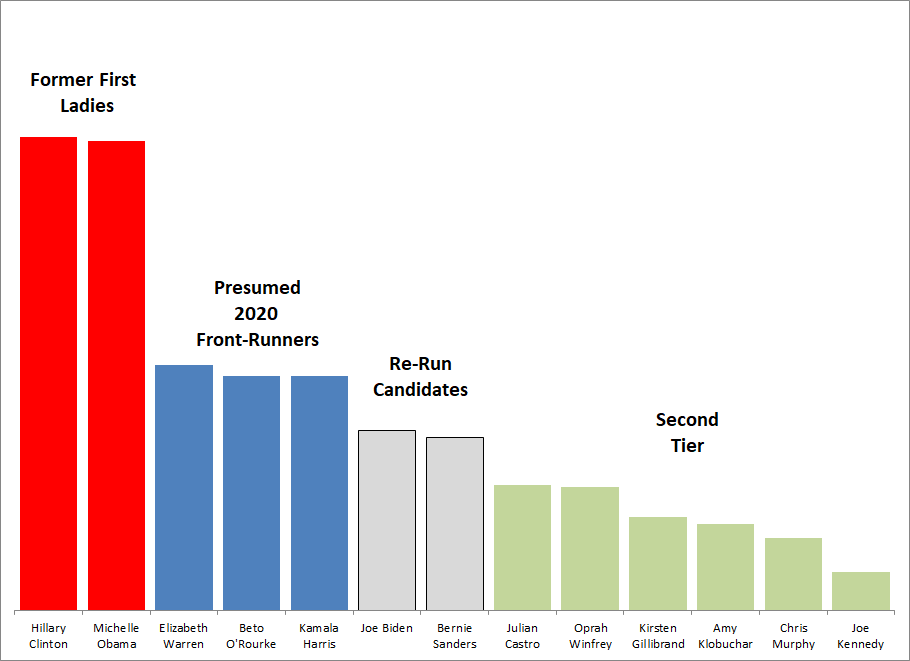** Note this is an excerpt from a previously published January 2019 report, prior to announcement by Kamala Harris of her intent to run
———————-
Social Media Influence (SMI) of potential candidates show that there seems to be four general clusters. Such clusters will not likely last, but in this early pre-campaign phase, they seem indicative of influence ranges. These clusters could be termed:
- Former First Ladies – Hillary Clinton and Michelle Obama have top tier SMI in a rather tight range. Instead of Former First Ladies, you could name this cluster ‘Hoped-For Candidates’ or ‘Iconic Democrats’. These Democrats have natural SMI leadership and are able to create influence with little to no effort. If either chose to run, they would naturally move directly to or near the top. Many Democrats claim they do not want Hillary Clinton running, but SMI states that the door is still open if she so chooses,
- New Generation Front-Runners – Warren, O’Rourke and Harris are the presumed 2020 Democratic front-runners based on SMI at this time. Their SMIs are extremely close, and depending on the day, leadership within this small cluster changes but the tight range has remained. Based on current SMI and consensus assumptions that neither Clinton nor Obama will run, the nomination will likely be an extremely tight race between these three candidates,
- Re-Run Candidates – Bernie Sanders and Joe Biden have previously run for president and are mostly household names. Even with such advantages, their SMIs struggle. Interestingly, they are in an extremely tight range, like those of the previous clusters mentioned. Other than being previous candidates (Hillary Clinton would also fall into this category), their demographic (older white males) has been a hot button topic within Democratic circles with many stating that Democrats should nominate any other demographic but theirs. During a different election cycle, their SMIs would likely fare better,
- Second Tier Candidates – most of the other eligible candidates fall into second tier status. Some look relatively stronger, but for the most part such candidates have received a boost due to their recent announcements confirming intention to run in 2020. Gillibrand and Castro both received bumps but have already begun to sink again post-announcement in terms of SMI. The range is not as tight in this cluster but in general SMIs tends to be stagnant at lower levels.
The top three clusters have extremely tight SMI ranges. The fact that individual candidates within these clusters seem to have similar traits could imply that social media users, at this stage of the campaign anyway, are inadvertently clumping them together.
Chart 2: Social Media Influence (SMI), 2020 Democrats, broken into four clusters
Source: ZettaCap
Some higher profile candidates have publicly announced their intention to run. Julian Castro and Kirstin Gillibrand received considerable boosts to SMI but each began to fade soon after their announcements. Though a short-term boost should be expected, such a rapid drift lower is disappointing. Without being able to sustain SMI at higher levels, these candidates should not be considered top tier contenders. If no major changes occur, we would expect these candidates to fade.
Oprah is the only potential candidate listed who does not neatly fall into a cluster. Her SMI is somewhere between the top tier and second tier candidates. At a level right between Castro and Gillibrand it is impressive considering these two candidates recently announced their respective bids for the presidency – without such announcements these other two would be considerably lower. If Oprah were to jump in, or even begin to comment more on politics, her SMI would most certainly jump to top tier status. Oprah is basically a wild card at this stage.
